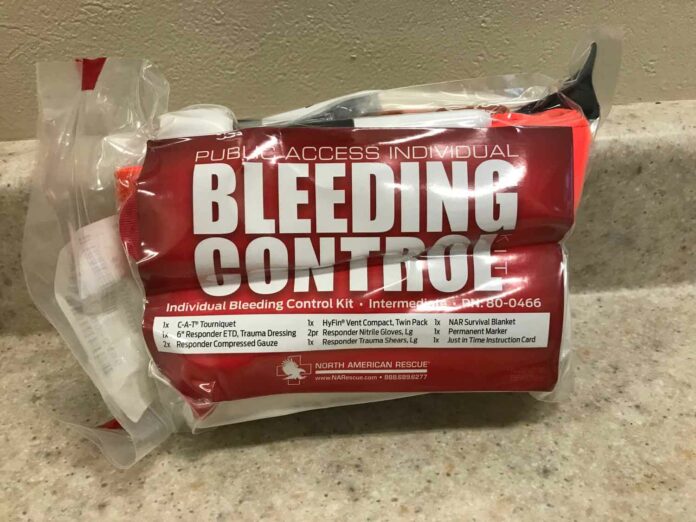Courtesy of Hazel Hawkins Memorial Hospital:
“Stop the Bleed” is a national awareness campaign aimed at encouraging bystanders to become trained and capable of helping victims in a bleeding emergency before professional help arrives. Hazel Hawkins Memorial Hospital (HHMH) and San Benito County Emergency Medical Services (EMS) have joined forces to accelerate “Stop the Bleed” training throughout the county, particularly in schools.
HHMH emergency department staff nurse Patricia Rovere, RN, PLN, and the EMS coordinator for San Benito County, Kris Mangano, are working in tandem to offer Stop the Bleed training locally. The training is as basic as CPR and involves learning how to compress a wound to control bleeding until an injured person can be taken to the hospital. Studies have shown that help given by an immediate responder can often make the difference between life and death.
Trainees also receive a Stop the Bleed kit containing all necessary equipment. Kits include an instructional booklet on bleeding control, a tourniquet, bleeding control dressing/gauze, a mini Sharpie marker, a pair of protective gloves, and a compression bandage. The basic kits are designed for one or two people, but School Resource Officers, police officers, and the sheriff department will carry larger kits capable of treating approximately 20 people. Fire engines and ambulances are already equipped with stop-the-bleed supplies.

The first school training will occur in September, with Mangano continuing to reach out to principals as the program progresses. “Our hope is to get the kits in every school this year,” says Mangano, “and provide school personnel with the knowledge to help others should there be an event that causes severe bleeding.” HHMH and EMS want to make sure every school in San Benito County receives training and one to four Stop the Bleed kits, depending on the size of the school.
Rovere is also focused on training more staff at HHMH to be trainers themselves. She emphasizes that bleeding deaths are among the top preventable causes of death. “Even though we have robust emergency services in our county, if something should happen and you have to wait for an ambulance for even four or five minutes after calling 911, that’s the time that people can die from a serious injury,” says Rovere.
As an ER nurse, Rovere sees a range of serious injuries and knows first-hand that learning how to compress and control bleeding—whether a person has been in a car accident, earthquake, or shooting—is a basic first aid skill that anyone can learn. Rovere says that with training, “You’re giving yourself and the people around you a better chance of survival.” She hopes that by educating people, everyone will be capable of saving a life.
Nationally, the Stop the Bleed initiative began after the active shooter disaster on December 14, 2012, at Sandy Hook Elementary School in Newtown, CT. A few months after the tragic event, the American College of Surgeons formed a committee comprised of members of the medical community, federal government, and military to create a national policy to enhance survivability from active shooter and mass casualty events. The committee’s recommendations are known as the Hartford Consensus and spurred grassroots efforts worldwide to decrease preventable bleeding deaths in our communities. More than one million people around the world have now been trained in Stop the Bleed.
In addition to schools, community groups interested in onsite Stop the Bleed training are encouraged to contact San Benito County EMS at (831) 636-4168. People can also visit www.bleedingcontrol.org to learn Stop the Bleed basics and order kits.




